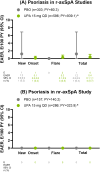Development of Extramusculoskeletal Manifestations in Upadacitinib-Treated Patients With Psoriatic Arthritis or Axial Spondyloarthritis
- PMID: 39624020
- PMCID: PMC12039472
- DOI: 10.1002/art.43069
Development of Extramusculoskeletal Manifestations in Upadacitinib-Treated Patients With Psoriatic Arthritis or Axial Spondyloarthritis
Abstract
Objective: To assess the development of extramusculoskeletal manifestations (EMMs) among patients with psoriatic arthritis (PsA) or axial spondyloarthritis (axSpA) treated with upadacitinib 15 mg.
Methods: Data (cutoff: August 15, 2022) from five clinical trials in PsA (2), radiographic axSpA (r-axSpA; previously ankylosing spondylitis) (2), and nonradiographic axSpA (nr-axSpA) (1) were analyzed. Treatment-emergent adverse events of EMMs including uveitis, inflammatory bowel disease (IBD), and psoriasis were assessed in patients treated with placebo, upadacitinib 15 mg, or adalimumab (PsA only) and are reported as exposure-adjusted event rates (events per 100 patient-years [E/100 PY]).
Results: Most patients (87.1%-99.3%) did not have a history of EMMs at baseline. In PsA, development of uveitis and IBD were low regardless of treatment or prior EMM history; rates were similar with upadacitinib 15 mg and adalimumab. In r-axSpA, development of uveitis was numerically lower (E/100 PY) in patients treated with upadacitinib 15 mg (2.8) versus placebo (7.5) and in patients with no history of uveitis (upadacitinib 15 mg 0.6; placebo 1.2) versus a history of uveitis (upadacitinib 15 mg 2.1; placebo 6.2); occurrence of IBD and psoriasis were low regardless of treatment or history. In nr-axSpA, development of uveitis was low regardless of history but was numerically lower in patients treated with upadacitinib 15 mg (0.9) versus placebo (2.1); occurrence of IBD and psoriasis were low or absent.
Conclusion: In patients with spondyloarthritis, development of EMMs was generally low with upadacitinib 15 mg. Uveitis was numerically lower in patients treated with upadacitinib 15 mg versus placebo, and particularly in r-axSpA. Regardless of treatment in r-axSpA, having a history of uveitis appeared to predispose patients for future uveitis events.
© 2024 The Author(s). Arthritis & Rheumatology published by Wiley Periodicals LLC on behalf of American College of Rheumatology.
Figures



References
-
- van der Heijde D, Molto A, Ramiro S, et al. Goodbye to the term ‘ankylosing spondylitis’, hello ‘axial spondyloarthritis’: time to embrace the ASAS‐defined nomenclature. Ann Rheum Dis 2024;83:547–549. - PubMed
-
- Ehrenfeld M. Spondyloarthropathies. Best Pr Res Clin Rheumatol 2012;26:135–145. - PubMed
-
- Ramiro S, Nikiphorou E, Sepriano A, et al. ASAS‐EULAR recommendations for the management of axial spondyloarthritis: 2022 update. Ann Rheum Dis 2023;82:19–34. - PubMed
MeSH terms
Substances
Grants and funding
LinkOut - more resources
Full Text Sources
Medical
Research Materials
Miscellaneous

